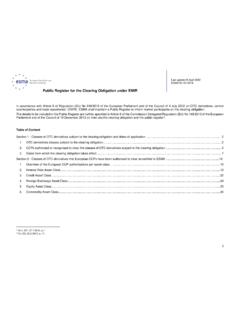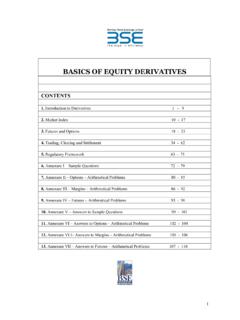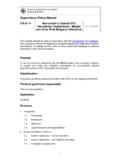Transcription of Derivatives markets, products and participants
1 IFC Bulletin No 35 3 Derivatives markets, products and participants : an overview Michael Chui1 1. Introduction Derivatives have been associated with a number of high-profile corporate events that roiled the global financial markets over the past two decades. To some critics, Derivatives have played an important role in the near collapses or bankruptcies of Barings Bank in 1995, Long-term Capital Management in 1998, Enron in 2001, Lehman Brothers in and American International Group (AIG) in 2008. Warren Buffet even viewed Derivatives as time bombs for the economic system and called them financial weapons of mass destruction (Berkshire Hathaway Inc (2002)). But Derivatives , if properly handled, can bring substantial economic benefits.
2 These instruments help economic agents to improve their management of market and credit risks. They also foster financial innovation and market developments, increasing the market resilience to shocks. The main challenge to policymakers is to ensure that Derivatives transactions being properly traded and prudently supervised. This entails designing regulations and rules that aim to prevent the excessive risk-taking of market participants while not slowing the financial innovation aspect. And it also calls for improved data quantity and quality to enhance the understanding of Derivatives markets. This chapter provides an overview of Derivatives , covering three main aspects of these securities: instruments, markets and participants .
3 It begins with a quick review of some key concepts, including what Derivatives are; why they exist; who use these instruments and for what purpose. It also discusses the factors that have contributed to the rapid growth of the markets over the past few decades. In section 3, the main types of derivative contracts will be discussed. Section 4 examines how specific Derivatives contracts are written on various underlying asset classes. Section 5 discusses two main types of markets: exchange-traded and over-the-counter. The key differences of these markets will be highlighted. Section 6 reviews some recent credit events and to what extent counterparty risk has played a role. Finally, section 7 concludes. 2. Derivative securities: some basic concepts The Oxford dictionary defines a derivative as something derived or obtained from another, coming from a source; not original.
4 In the field of financial economics, a derivative security is generally referred to a financial contract whose value is derived from the value of an underlying asset or simply underlying. There are a wide range of financial assets that have been used as underlying, including equities or equity index, fixed-income instruments, foreign currencies, commodities, credit events and even other derivative securities. Depending on the types of underlying, the values of the derivative contracts can be derived from the corresponding equity prices, interest rates, exchange rates, commodity prices and the probabilities of certain credit events. 1 former Senior Economist, BIS Representative Office for Asia and the Pacific, Hong Kong 4 IFC Bulletin No 35 What is the main function of Derivatives ?
5 They allow users to meet the demand for cost-effective protection against risks associated with movements in the prices of the underlying. In other words, users of Derivatives can hedge against fluctuations in exchange and interest rates, equity and commodity prices, as well as credit worthiness. Specifically, derivative transactions involve transferring those risks from entities less willing or able to manage them to those more willing or able to do so. Derivatives transactions are now common among a wide range of entities, including commercial banks, investment banks, central banks, fund mangers, insurance companies and other non-financial corporations. participants in Derivatives markets are often classified as either hedgers or speculators . Hedgers enter a derivative contract to protect against adverse changes in the values of their assets or liabilities.
6 Specifically, hedgers enter a derivative transaction such that a fall in the value of their assets will be compensated by an increase in the value of the derivative contract. By contrast, speculators attempts to profit from anticipating changes in market prices or rates or credit events by entering a derivative contract. According to this definition, activities of speculators are inherently more risky and should warrant close monitoring by financial regulators. However, it is difficult to differentiate the two in practice. As pointed out by Jarrow and Turnbull (20), Hedging risk reduction speculation risk augmentation are flip sides of the same coin. Hedging and speculating are not the only motivations for trading Derivatives . Some firms use Derivatives to obtain better financing terms.
7 For example, banks often offer more favourable financing terms to those firms that have reduced their market risks through hedging activities than to those without. Fund managers sometimes use Derivatives to achieve specific asset allocation of their portfolios. For example, passive fund managers of specific index-tracking funds may need to use Derivatives to replicate exposures to some not so liquid financial assets. Derivatives have a long history and early trading can be traced back to Venice in the 12th Credit derivative deals at that period took the form of loans to fund a ship expedition with some insurance on the ship not returning. Later in the 16th century, Derivatives contracts on commodities emerged. During that time, the slow speed in communication and high transportation costs presented key problems for traders.
8 Merchants thus used Derivatives contracts to allow farmers to lock in the price of a standardised grade of their produces at a later delivery date. A number of fundamental changes in global financial markets have contributed to the strong growth in derivative markets since the 1970s. First, the collapse of the Bretton Woods system of fixed exchange rates in 1971 increased the demand for hedging against exchange rate risk. The Chicago Mercantile Exchange allowed trading in currency futures in the following year. Second, the changing of its monetary policy target instrument by the US Federal Reserve (FED) promoted various Derivatives markets. The adoption of a target for money growth by the FED in 1979 has led to increased interest-rate volatility of Treasury bonds.
9 That in turn raised the demand for Derivatives to hedge against adverse movements in interest rates. Later in 1994 when the US Federal Open Market Committee moved to explicitly state its target level for the federal funds rate, that policy has spurred the growth of Derivatives on the federal funds rates. Third, the many emerging market financial crises in the 1990s, which were often accompanied by a sharp rise in corporate bankruptcy, greatly increased the demand of global investors for hedging against credit risk. 2 See Swan (2000). IFC Bulletin No 35 5 Fourth, innovation in financial theory was another contributing factor. The advancements in options pricing research, most notably the Nobel-prize winning Black-Scholes options pricing model, provided a new framework for portfolio managers to manage risks.
10 More importantly, the rapid improvements in computer technology in the 1990s allowed these asset managers to design and develop increasingly sophisticated Derivatives as part of their risk management tools. 3. Major types of Derivatives There are four main types of Derivatives contracts: forwards; futures, options and swaps. This section discusses the basics of these four types of Derivatives with the help of some specific examples of these instruments. Forwards and futures contracts Forward and futures contracts are usually discussed together as they share a similar feature: a forward or futures contract is an agreement to buy or sell a specified quantity of an asset at a specified price with delivery at a specified date in the future. But there are important differences in the ways these contracts are transacted.
















